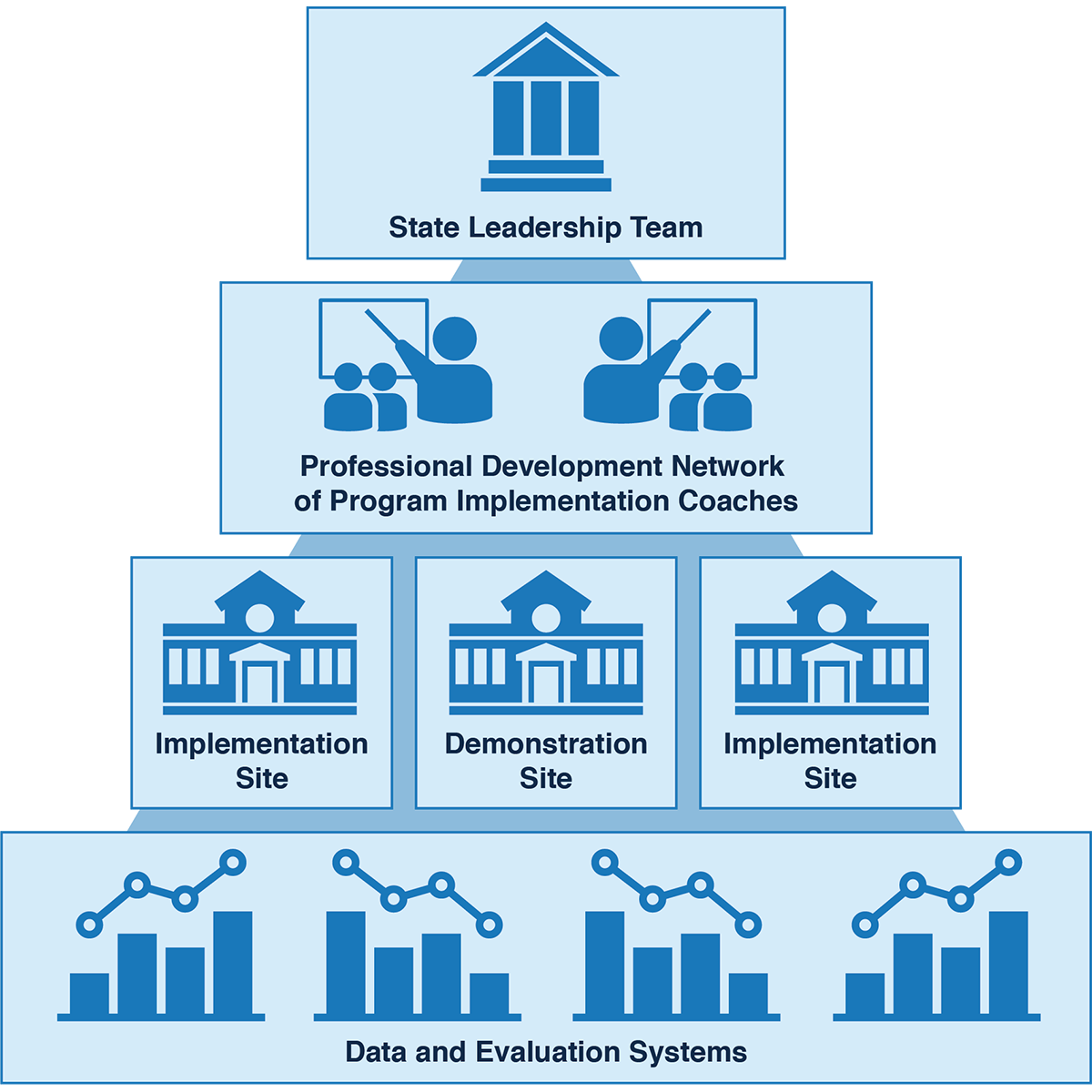Early Childhood Implementation Snapshots, No. 2: Statewide Leadership Team
- updated January 31, 2025
- by Angie Van Polen
State Leadership Team (SLT) is a cross-sector group that is responsible for planning and supervising a chosen initiative, which includes several other sub elements: funding, policy initiatives, evaluation, data-based decision making, training and coaching, site selection and public awareness. The culmination of these intentional efforts is to ensure the SLT effectively plans to provide supports and resources across early childhood systems ensuring implementation, scaling up and sustainability of evidence-based practices to fidelity.



There are multi-functions of the SLT, which are guided by the State Leadership Team Benchmarks of Quality tool. SLTs use this self-assessment tool to guide the state initiative, assess progress and plan future actions by engaging in the following:
- Forming a Professional Development Network of Program Implementation Coaches to provide professional development and training to implementation sites
- Selecting Implementation and Demonstration Sites
- Creating a site evaluation plan for collecting data to evaluate fidelity of implementation and child and family outcomes
- Carrying out a short and long-term plan to scale-up and sustain
Resource Spotlight
The Statewide Implementation Guide provides tools to assist State Leadership Teams from the exploration stage all the way to the scale up and sustainability stage. States have found planning a short and long-term sustainability and scale up plan to be critical. Here are two documents to guide this process:
- Considerations for a Written Sustainability and Scale-Up Plan
- Sustainability and Scale-Up Planning Worksheet
Voices from the Field: Connecticut

The Connecticut Pyramid Partnership Team has utilized the SIG as their foundation for developing a statewide Pyramid Model Implementation Strategic Plan. This strategic plan is used in conjunction with the state leadership team's action plan based on the state's Benchmarks of Quality self-assessment. These plans guide the work of the leadership team in undertaking short, mid and long-term planning goals. The strategic plan addresses the larger Connecticut Office of Early Childhood's (OEC) plan to sustain and scale Pyramid Model implementation in the state. In order to scale and sustain Pyramid Model efforts successfully the team considers each of the essential support structures outlined in the Statewide Implementation Guide.
Connecticut's strategic plan describes Pyramid Model and how extensive the framework for state-wide implementation is, as well as how the model stresses scale up and sustainability at all levels. Deb Resnick, Manager, Connecticut Office of Early Childhood adds:
"It also to a lesser extent outlines where we are in the implementation, where we hope to be in 5 years, and how we will get there. The strategic plan reminds us to be certain that everything we do spreads the word to as many people as possible, and demonstrates use of funds to scale up and sustain Pyramid Model efforts guided by the leadership team."
The strategic plan includes ways in which funds would support Pyramid Model work, but is not limited to the following:
- Pay independent contractors as coaches and trainers
- Provide a subsidy to programs to support teachers having substitutes during training
- Provide funds to pay a coach to support the Program Implementation Coaches
By following the Statewide Implementation Guide's guidance Connecticut has completed a strategic plan and used it as a roadmap with very clear directions on how to increase their success of Pyramid Model implementation to reach fidelity. Deb Resnick described the strategic plan as:
"An overarching document used to justify our budget and request funds, as well as highlight how the funds and the items in the SLT's action plan will lead to the funding agencies' goal of getting Pyramid out as widely as possible considering scale up, sustainability and fidelity."
See also: OEC Strategic Plan For Pyramid Model Implementation in Connecticut
Considerations
- Does your SLT have cross sector representation?
- Does your SLT have broad stakeholder representation including, but not limited to licensing and regulations/childcare representatives, Head Start, preschool special education, state-funded preschool, K-12 systems alignment, higher education, tribal bureaus, educational agencies that provide professional development and technical assistance at a state level?
- Is your SLT representation consistent with the state? Considerations given to population data such as urban, rural, small rural, tribal communities, etc.
- Does your SLT have Parent Training and Information Centers (PTI) and other groups representing families?
Planning Tools
The Hexagon: An Exploration Tool: Discussion and Analysis Guide
The Hexagon Tool can be used by communities and organizations to better understand how a new or existing program or practice fits into an implementing site's existing work and context. The Hexagon Tool can be used at any stage of implementation to assess fit and feasibility. It is most commonly used during the Exploration stage when an implementing site is identifying and selecting new programs and practices to implement.
Considerations for Policy
An SLT can guide the team to move policy forward through stages using a model process for the development of public policies and sustainability.
- Agenda Setting: Has the problem situation been identified and evidence collected by SLT?
- Policy Formulation: Have the policy levers (consequences and impact) for intervention been identified?
- Adoption: Have the policy approaches at the governmental level been decided?
- Implementation: Have the consequences and impacts of adopted policies been documented?
- Policy Evaluation: Have discrepancies between the policy's expected and actual results been revealed?
References
- Statewide Implementation Guide. (2019). ECTA Early Childhood Technical Assistance Center. https://ectacenter.org/sig
- OEC Strategic Plan for Pyramid Model in Connecticut. National Center for Pyramid Model Innovations. (2021). https://challengingbehavior.org/docs/CT_strategic_plan.pdf
- Benoit, F. (2013). Public Policy Models and Their Usefulness in Public Health: The Stages Model. Montréal, Québec: National Collaborating Centre for Healthy Public Policy.
The contents of this page were developed under cooperative agreements from the U.S. Department of Education, #H326P17001 (ECTA Center), and #H326B170003 (NCPMI), from the Office of Special Education Programs, U.S. Department of Education. However, these contents do not necessarily represent the policy of the U.S. Department of Education, and you should not assume endorsement by the Federal Government.

